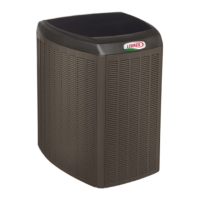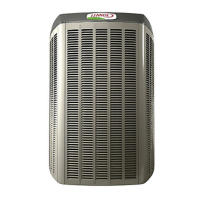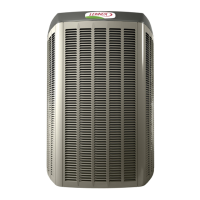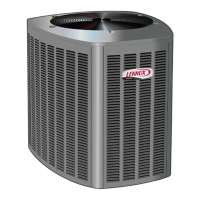Page 26
XP21
Servicing Units Delivered Void of Charge
If the outdoor unit is void of refrigerant, clean the system us-
ing the procedure described below.
1. Leak check system using procedure outlined on page
19.
2. Evacuate the system using procedure outlined on
page .
3. Use nitrogen to break the vacuum and install a new fil-
ter drier in the system.
4. Evacuate the system again using procedure outlined
on page .
5. Weigh in refrigerant using procedure outlined in figure
17.
6. Monitor the system to determine the amount of mois-
ture remaining in the oil. It may be necessary to replace
the filter drier several times to achieve the required dry-
ness level. If system dryness is not verified, the
compressor will fail in the future.
Unit Start−Up
IMPORTANT
If unit is equipped with a crankcase heater, it should be
energized 24 hours before unit start−up to prevent
compressor damage as a result of slugging.
1. Rotate fan to check for binding.
2. Inspect all factory− and field−installed wiring for loose
connections.
3. After evacuation is complete, open both the liquid and
vapor line service valves to release the refrigerant
charge contained in outdoor unit into the system.
4. Replace the stem caps and tighten to the value listed
in table 1.
5. Check voltage supply at the disconnect switch. The
voltage must be within the range listed on the unit’s
nameplate. If not, do not start the equipment until you
have consulted with the power company and the volt-
age condition has been corrected.
6. Set the thermostat for a cooling demand. Turn on pow-
er to the indoor indoor unit and close the outdoor unit
disconnect switch to start the unit.
7. Recheck voltage while the unit is running. Power must
be within range shown on the nameplate.
8. Check system for sufficient refrigerant by using the
procedures listed under System Refrigerant.
System Refrigerant
This section outlines procedures for:
1. Connecting gauge set for testing and charging as illus-
trated in figure 15.
2. Checking and adjusting indoor airflow as described in
figure 16.
3. Add or remove refrigerant using the weigh in method
provided in figure 17, and verifying charge using sub-
cooling method described in figure 18.
TO LIQUID
LINE SERVICE
VALVE
TEMPERATURE
SENSOR
DIGITAL SCALE
REFRIGERANT TANK
TEMPERATURE SENSOR
(LIQUID LINE)
MANIFOLD GAUGE SET
A CLOSE MANIFOLD GAUGE SET VALVES AND CONNECT THE CENTER HOSE TO A CYLINDER OF HFC−410A. SET FOR LIQUID PHASE CHARGING.
B CONNECT THE MANIFOLD GAUGE SET’S LOW PRESSURE SIDE TO THE TRUE SUCTION PORT.
C CONNECT THE MANIFOLD GAUGE SET’S HIGH PRESSURE SIDE TO THE LIQUID LINE SERVICE PORT.
D POSITION TEMPERATURE SENSOR ON LIQUID LINE NEAR LIQUID LINE SERVICE PORT.
OUTDOOR UNIT
CHARGE IN
LIQUID PHASE
CONNECTIONS FOR TESTING AND CHARGING
GAUGE SET
A
C
D
LOW
HIGH
B
INSIDE OUTDOOR UNIT
TRUE SUCTION PORT
CONNECTION
Figure 15. Gauge Set Connections

